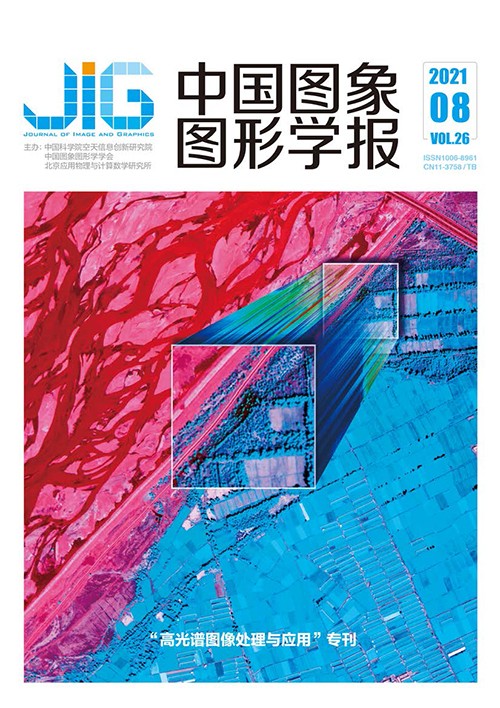
HSRS-SC:面向遥感场景分类的高光谱图像数据集
摘 要
目的 场景分类是遥感领域一项重要的研究课题,但大都面向高分辨率遥感影像。高分辨率影像光谱信息少,故场景鉴别能力受限。而高光谱影像包含更丰富的光谱信息,具有强大的地物鉴别能力,但目前仍缺少针对场景级图像分类的高光谱数据集。为了给高光谱场景理解提供数据支撑,本文构建了面向场景分类的高光谱遥感图像数据集(hyperspectral remote sensing dataset for scene classification,HSRS-SC)。方法 HSRS-SC来自黑河生态水文遥感试验航空数据,是目前已知最大的高光谱场景分类数据集,经由定标系数校正、大气校正等处理形成。HSRS-SC分为5个类别,共1 385幅图像,且空间分辨率较高(1 m),波长范围广(380~1 050 nm),同时蕴含地物丰富的空间和光谱信息。结果 为提供基准结果,使用AlexNet、VGGNet-16、GoogLeNet在3种方案下组织实验。方案1仅利用可见光波段提取场景特征。方案2和方案3分别以加和、级联的形式融合可见光与近红外波段信息。结果表明有效利用高光谱影像不同波段信息有利于提高分类性能,最高分类精度达到93.20%。为进一步探索高光谱场景的优势,开展了图像全谱段场景分类实验。在两种训练样本下,高光谱场景相比RGB图像均取得较高的精度优势。结论 HSRS-SC可以反映详实的地物信息,能够为场景语义理解提供良好的数据支持。本文仅利用可见光和近红外部分波段信息,高光谱场景丰富的光谱信息尚未得到充分挖掘。后续可在HSRS-SC开展高光谱场景特征学习及分类研究。
关键词
HSRS-SC: a hyperspectral image dataset for remote sensing scene classification
Xu Kejie1, Deng Peifang1, Huang Hong1,2(1.Key Laboratory of Optoelectronic Technology and Systems of the Education Ministry of China, Chongqing University, Chongqing 400044, China;2.State Key Laboratory of Coal Mine Disaster Dynamics and Control, Chongqing University, Chongqing 400044, China) Abstract
Objective Remote sensing scene classification is an important research topic in remote sensing community, and it has provided important data or decision support for land resource planning, coverage mapping, ecological environment monitoring, and other real-world applications. In scene classification, extracting scene-level discriminative features is a key factor to bridge the "semantic gap" between low-level visual attributes and high-level understanding of images. Deep learning models are currently showing excellent performance in remote sensing image analysis, and many convolutional neural network (CNN)-based methods have been widely proposed in feature extraction and classification of remote sensing scene images. Although the aforementioned methods have achieved good results, they are all designed for scene images of high spatial resolution, such as University of California(UC) Merced Land-Use, WHU-RS19, scene image dataset designed by RS_IDEA Group in Wuhan University(SIRI-WHU), RSSCN7, aerial image dataset(AID), a publicly available benchmark for remote sensing image scene classification created by Northwestern Polytechnical University(NWPU-RESISC45), and optical imagery analysis and learning(OPTIMAL-31) datasets. Remote sensing data of high spatial resolution can present spatial details of ground objects. However, they contain less spectral information. As a result, their discriminative ability is relatively limited in scene classification. Hyperspectral images have abundant spectral information, and they have strong discriminative ability for ground objects. However, the existing datasets of hyperspectral images (e.g., Indian Pines, Pavia University, Washington DC Mall, Salinas, and Xiongan New Area) are mostly oriented toward pixel-level classification and are difficult to directly apply on research of scene-level image classification. Tiangong-1 hyperspectral remote sensing scene classification dataset (TG1HRSSC) is produced for scene-level image interpretation. However, the TG1HRSSC dataset is small (204 scene images) and has inconsistent image bands. A hyperspectral remote sensing dataset is constructed for scene classification (HSRS-SC) in this study to overcome the aforementioned disadvantages. The dataset can provide a good benchmark platform for evaluating intelligent algorithms of hyperspectral scene classification. Method The HSRS-SC is derived from the aerial data of the Heihe Watershed Allied Telemetry Experimental Research (HiWATER), and raw data can be downloaded from the National Tibetan Plateau/Third Pole Environment Data Center. A large-scale dataset is finally formed after calibration coefficient correction, atmospheric correction, image cropping, and manual visual annotation. To the best of our knowledge, the HSRS-SC is currently the largest hyperspectral scene dataset, and it contains 1 385 hyperspectral scene images which have been resized to 256×256 pixels. The dataset is divided into 5 categories, and the number of samples in each category ranges from 154 to 485. In the HSRS-SC dataset, each hyperspectral scene image has a high spatial resolution (1 m) and a wide wavelength range (from visible light to near-infrared, 380~1 050 nm, 48 bands), which can reflect the detailed spatial and spectral information of ground objects, including cars, roadway, buildings, and vegetation. Specifically, the blue band (450~520 nm) has a certain penetration ability to water bodies; the green band (520~600 nm) is more sensitive to the reflection of vegetation; the red band (630~690 nm) is the main absorption band of chlorophyll; the near-infrared band (760900 nm) reflects the strong reflection of vegetation, and it is also the absorption band of water bodies. The dataset will be publicly available in the near future, and it can be used for non-commercial academic research. Result This study uses three classic deep models (i.e., AlexNet, VGGNet-16, and GoogLeNet) to organize experiments under three different schemes for providing benchmark results of HSRS-SC dataset. In the first scheme, false color images are synthesized from the 19th, 13th, and 7th bands of visible light range, and then, they are fed into deep models to extract global scene features. In the second and third schemes, information of the visible light (19th, 13th, and 7th) and near-infrared (46th, 47th, and 48th) bands are comprehensively utilized by fusion approaches of addition and concatenation, respectively. In the experiments, 10 samples per class are randomly selected to finetune pre-trained CNN models, and the rest are used for test set. The experimental results on the HSRS-SC dataset show that the effective utilization of information from different bands of hyperspectral images improves the classification performance, and concatenation fusion achieves better results than addition fusion. Comparing the three CNN models shows that the VGGNet-16 model is more suitable for the HSRS-SC dataset, and the highest overall classification accuracy reaches 93.20%. Furthermore, this study shows confusion matrices of different methods. Effective use of spectral information can reduce the confusion of semantic categories given that vegetation, buildings, roads, water bodies, and rocks have great differences in absorption and reflection at different bands. This study also organizes hyperspectral scene classification experiments to further explore the advantages of hyperspectral scenes. Hyperspectral scenes have a higher accuracy advantage than RGB images under the two training samples. Conclusion The abovementioned experimental results show that the HSRS-SC dataset can reflect detailed information of ground objects, and it can provide effective data support for semantic understanding of remote sensing scenes. Although experiments in this study adopt three different schemes to utilize the information of the visible light (19th, 13th, and 7th bands) and near-infrared (46th, 47th, and 48th bands) of the hyperspectral scenes, the rich spectral information has not been fully explored. For the future work, suitable models will be designed for feature extraction and classification of hyperspectral remote sensing scenes. We will also further expand the HSRS-SC dataset to ensure its practicality by supplementing more semantic categories and the total number of samples and increasing the diversity of data.
Keywords
|



 中国图象图形学报 │ 京ICP备05080539号-4 │ 本系统由
中国图象图形学报 │ 京ICP备05080539号-4 │ 本系统由